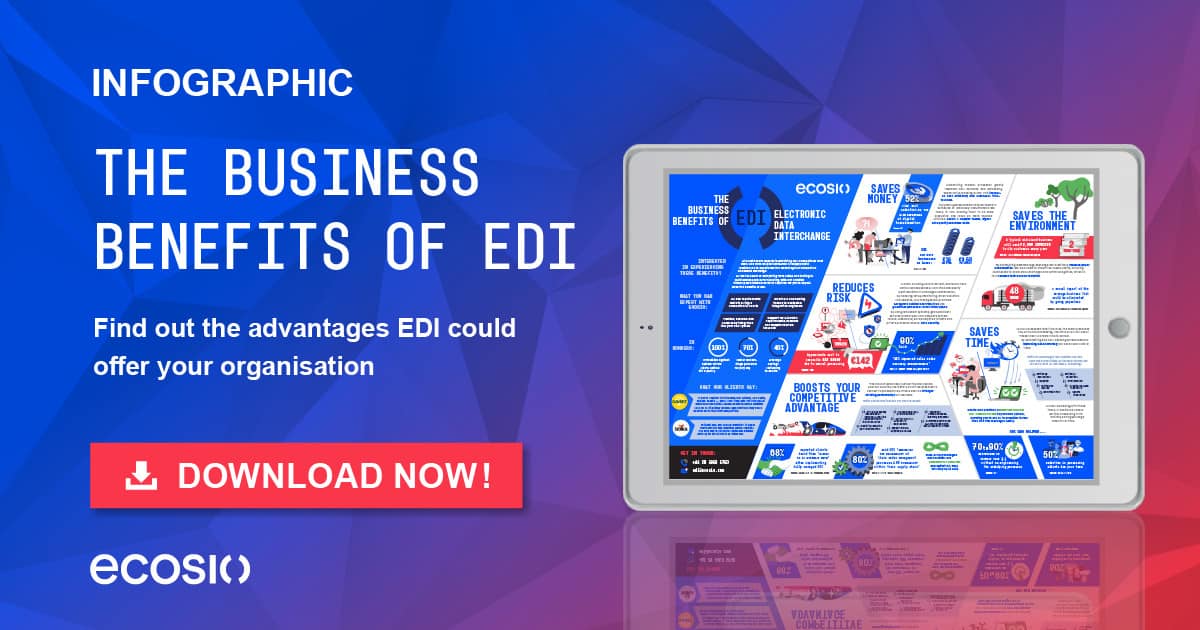As the old saying goes, time is money; and nowhere is this more relevant than in the world of B2B transactions. From data entry errors to message failures and delays, inefficient B2B processes can cost businesses dearly. By offering a means to automate B2B communication, electronic data interchange (EDI) and EDI interfaces enable businesses to both save time and improve efficiency – in turn resulting in significant cost savings!
Contrary to what many think, setting up a successful EDI interface isn’t rocket science. In fact, with the support of the right EDI provider, you can start reaping the benefits of a good EDI interface in no time. But what exactly makes a good EDI interface? How does an EDI interface work, and what benefits can a good interface offer? In this article we’ll answer all of these questions and more.
What is an EDI interface?
An EDI interface is a technical platform that enables the electronic exchange of structured business data between different systems. EDI interfaces are crucial in business communication, where they automate the manual exchange of documents (such as purchase orders, invoices and shipping notifications).
Simply put, an EDI interface converts data from internal systems (e.g. accounting software) into a standardised format – and vice versa. Once in standardised format, the data is automatically sent to the relevant external party (e.g. a customer or supplier). Not only does this automated process save time, it also greatly reduces the potential for errors, as the need for manual data input is removed on both the sender and receiver’s sides.
How does an EDI interface work?
An EDI interface can be set up via different communication channels: via the internet, via direct connections between systems or via special EDI networks.
The data transfer between sender and receiver is based on the three “C”s: connectivity, conversion and communication.
- Connectivity. Before anything else, the sender and receiver must define a common, structured data format, e.g. EDIFACT or XML, which is then used for all exchanges via the EDI interface. In most cases the format to be used is dictated by the customer via a message implementation guideline (MIG).
- Conversion. Once this format has been chosen, mapping must be done to ensure that data is correctly converted from whatever inhouse format is being used (e.g. IDocs in SAP systems) to the agreed EDI format. This step involves a lot of technical expertise and testing.
- Communication. Once mapping has been set up, the next step is handling how the data is transferred – i.e. what transfer protocol should be used. Protocols are the means by which data is securely transferred to the recipient, with popular protocols including AS2, HTTP, OFTP2, REST API and web services.
On the recipient’s side, the process then takes place backwards: they receive the data via their EDI interface and convert it into its internal format before validating and processing it. After processing, the receiver sends a response to the sender to confirm the successful receipt of the data as well as its processing. In the event that processing problems occur, the response may also include error messages.
The four most common problems with EDI interfaces
As we’ve mentioned already, when implemented well, an EDI interface can provide many benefits, from helping businesses save time and money, to reducing risk and boosting attractiveness to partners. However, there are many things that can prevent an interface from delivering maximum value. These include…
- Not being user-friendly. Given the extent of the technical work required to send and receive EDI messages, EDI interfaces are often complicated to use, with data accessible only to IT personnel. In such situations, IT can easily become a bottleneck, and the potential value that EDI can offer is limited.
- Lack of flexibility. Whether due to internal or external factors, EDI requirements inevitably change over time. Unfortunately, not all EDI interfaces lend themselves to quick adjustments, however. For example, if an EDI interface is maintained by in-house staff members who have other responsibilities – as opposed to external experts – tasks such as onboarding new partners or changing complicated mappings may take a long time to complete.
- Dependence on in-house technical expertise. The implementation of a good EDI interface requires a lot of technical expertise, both during setup and ongoing operation. If EDI tasks are to be handled internally and inhouse resources are lacking, this can be a real issue.
- Rushed implementation. Despite the fact that EDI is essential in modern B2B relationships, it’s rarely given sufficient consideration in ERP migration projects. As a result, EDI interfaces are often implemented at the end of migration projects, with ERP customisers rushing to find something that can do the job rather than taking the time to select a well-suited, futureproof solution.
What makes a good EDI interface?
A good EDI interface is characterised by several features.
- It should allow seamless integration to ensure smooth data exchange between different systems.
- It should be flexible and support diverse data formats to meet the requirements of different business partners.
- It should be secure and provide mechanisms for data encryption and authentication in order to guarantee the confidentiality and integrity of the transmitted data.
- It should be scalable and able to adapt as your EDI needs evolve over time.
- It should have extensive message monitoring and error handling functions to allow for errors to be spotted and resolved quickly.
Perhaps the most important feature of a successful EDI interface, however, is data visibility.
Given the significance of the data being exchanged via EDI, relevant departments having real-time visibility of key information – such as whether or not a partner has received or opened an invoice – is extremely important. Similarly, having access to an EDI dashboard which offers a helpful overview of EDI message flow can make message monitoring much easier.
Despite this, such functionality is only offered by a minority of EDI interfaces – namely those which utilise an API connection…
How an API connection can boost efficiency
As a collection of rules and protocols, an API connection defines how the various exchange formats, exchange protocols and security requirements of an EDI interface should interact. The main advantage of EDI interfaces based on API connections is that the data is accessed directly. This means that no metadata is lost and important information such as whether an invoice has been received by the EDI service provider or by the final message recipient can be displayed in real time in the existing user interface of the user’s ERP system. This improves supply chain efficiency and minimises the occurrence of errors.
When errors do occur, the data transparency offered by API connections is also extremely helpful, as the user can easily determine where the problem lies and what needs to be done to resolve it. EDI interfaces which utilise API connections may also offer added benefits such as full-text search functionality, which allows EDI messages to be found quickly by searching for any known identifier, such as article number or transmission ID.
Another key benefit of connecting an EDI interface via API is that specialist teams such as sales or purchasing don’t need to go through IT to get key information. By improving data visibility and accessibility and allowing relevant employees to access data directly in their ERP system, using an API connection eliminates internal bottlenecks.
In short, EDI interfaces that utilise an API connection help businesses to streamline B2B processes by ensuring that all relevant parties have real-time visibility of important information, that information can be located easily, and that errors can be resolved quickly.
Want to know more?
Want to know more about EDI and how ecosio’s unique EDI as a Service solution could help you? Then contact us today! Our EDI experts will be more than happy to show you how you could leverage efficient EDI to save time, save money, reduce risk and boost your competitive advantage.
Discover more about our updated product, ecosio.flow.













